Last Updated on June 14, 2023

“No poem was ever written by a drinker of water” Horace
Estimated reading time: 23 minutes
By Karen La Rosa
Sicily, the largest island in the Mediterranean, is becoming a very popular destination with travelers. It’s also a rising star in the world of winemaking.

Although grapes have been cultivated in Sicily for some 6,000 years, as recent discoveries attest, the island has evolved to become a unique wine region, a darling that is the talk of wine and travel aficionados alike. Sicily’s diverse microclimates, varied growing environments, and a wealth of indigenous grapes have caught the attention of the world, and the world is excited.
I’ve met many of these aficionados. I bring them to wineries in Sicily for fun and illuminating afternoons, to experience the excellent and interesting Sicilian wines, the authentic Sicilian food that typically accompanies it, and to linger in the warmth of good hospitality. The gorgeous landscapes are a breathtaking bonus.

Wines and Wineries in Sicily
Wineries in Sicily have become known worldwide for their refined artistry. On this dry, mountainous island, every glass is a reflection of its content’s terroir.
Ironically, although statistically Sicily is at the top of the 20 wine-producing regions of Italy, Sicilians drink the least of all Italians.
Despite that, they are surrounded by 250,000 acres of vineyards…at sea level, on the rolling hills of the interior, and on mountain sides. 10% of them are even on the slopes of a volcano, Mount Etna, Europe’s most active.
Today almost 300 producers create Sicilian wines mostly by hand, battling the elements to achieve beautiful, unique results.
Drink a wine made from the grapes of Etna and you’ll most definitely taste the volcano. Grow those same grapes not too far away and you’ll be surprised how the wine changes.

The Historical Perspective of Wineries in Sicily
Around 800 BC, the Phoenicians brought grapes with them from the Southern Mediterranean. The Greeks who followed brought a more advanced knowledge of viticulture. Subsequent foreign conquerors, numbering more than a dozen, continued to have a cultural impact on Sicily until 1861, when the island was unified with mainland Italy. Through it all, however, there was wine.

Traveler’s fascination with this history, the urge to see the beauty of the island, and an interest in the Sicilians themselves, is why tourism has become such a significant part of Sicily’s economy.
But a new history is now developing in Sicily. The renaissance of interest in wineries in Sicily is bringing many new travelers to the island and is catapulting tourism numbers to new heights.
Visits from wine journalists, bloggers and critics, all looking for something new, bring attention to the region as a whole, with the wines of Mount Etna becoming the sweethearts of the media. These media take home warm and intimate experiences not only of Sicilian wines themselves, but also of the owners of the vineyards and the stunning, always-changing landscapes they encounter.
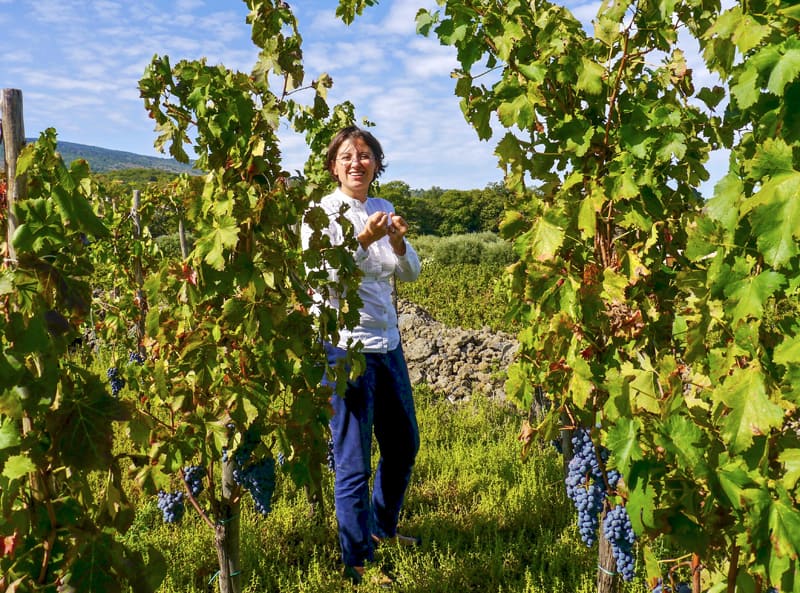
The Art of Sicilian-Wine Making
The process of making wine is an art, and at the wineries in Sicily most of it is accomplished by hand. It includes blending the best of traditional and modern methods.
The artistry is a result of the enormous number of daily decisions and options required in the vineyards as well as in the cantina/cellar. They include each vintner’s philosophy about wine, and his or her painstaking effort, knowledge, and even imagination. At Cantine Barbera in Menfi, one of the wines is made without the use of electricity! Of course, there is the fundamental reliance on Mother Nature, the climate and soil.
Wine making is not for the faint of heart. In fact, it is almost heroic…which makes each bottle unique and precious.

The French Market for Wineries in Sicily
Sicily’s agricultural and cultural heritage has included wine for millennia. Rustic table wines, bulk wines (known as sfuso), and fortified wines, were the predominant wines in Sicily for ages.
Drunk locally, these heavy and highly alcoholic Sicilian wines found a market in France, where they were blended with local wines to develop body, depth and color. Even Northern Italy began relying on Sicily’s heartier wine production to refine its own wines.
Then, in the late 1800’s, much of Europe was devastated by phylloxera. The disease, caused by a root-eating louse-like pest, destroyed an incredible number of vines.
Like the rest, the wineries in Sicily lost a vast number, and its viticulture took decades to recuperate. Some vineyards escaped harm, whether because of sandy soils with good drainage or just good luck, making it still possible to find vecchie vigne (old vines) in Sicily.

The Renaissance of Sicilian Wine
In the 1950s, a greater appreciation of wine evolved and the business of sending Sicilian wines to the north to blend, fell out of practice in favor of the desire for single varietals and lower-alcohol wines in general.
Then, in the 1970’s, US interest in consuming Italian wines began to rise. Producers in Sicily, both independently and collectively, started thinking about the future of Sicilian wine.

Bulk Sicilian wine continued to be enjoyed at the family table and in local restaurants (and is still), often coming in unmarked bottles from local cooperatives. But with this new dedication to quality, all wine in Sicily began to improve.
Sicilian winemakers realized that they had been ignoring the very potential of their own lands, perfectly suited to wine production because of climate and overall fertility. They began to develop a Sicilian-wine image, an image carefully crafted to include history, tradition, family pride, and an openness to new ideas and winemakers.
Evolution, education, promotion, and regulation began to give rise to a robust interest in the non-table wine segment in Sicily. While the volume of Sicilian wine actually decreased, the quality of the wine was much higher than ever before.
Today many of the island’s wines are described as “elegant,” “meditative,” “structured,” and “refined,” much like – and commanding prices similar to – their French counterparts. They also compete for space in the best restaurants and stores worldwide.

Success in the Wineries of Sicily
Credit must be given to some of the historically important Sicilian wine-making families. Among them are Tasca, Planeta, Rallo, Alliata, De Bartoli, Florio, Occhipinti, Nicolosi and Benanti, all names we are still familiar with today.

These families took chances, risked fortunes, and mentored smaller families in the business to help elevate them in tandem. They worked to improve the production of Sicily’s indigenous grapes, tied so closely to the island’s history and microclimates of their terroir. They also began importing international grapes, such as Chardonnay and Syrah, that appeal to a wide audience of wine drinkers.
The fruits of their labors have drawn much praise, and the results today are stunning. Assovini, an association of wineries, said that 2019 was their most successful vintage in history.
Also, in the traditionally male world of Sicilian winemaking there are finally a growing number of women enologists. Marilena Barbera, for one, has a very decided view of growing grapes and making wines.
This new generation of winemakers is young, educated, well-traveled and dynamic. They have studied their vineyards and learned from generations of work before them. They have inherited their roles as the new stewards.

A Variety of Sicilian Vineyards
Vineyards are interesting places and everything that happens in the growing season affects the resulting wine. Incredibly, Sicily’s unusually varied microclimates mean that harvesting in Sicily can begin in August and run through early November.
Then decisions in the winemaking begin, decisions that are infinite and can involve fermentation temperature, storage in barrels or stainless steel, time in the bottle before releasing the wine, and many more.

Factors such as altitude, soil type, wind, sun, proximity to the sea and the volcano, all make a difference in the wine’s color, aroma and flavor. Hence, a Nero d’Avola grown near Noto in eastern Sicily will taste very different than one from Menfi or Camporeale further west.
Most people are surprised to learn that the majority of grapes in production are white varieties, 60% or mostly Catarratto (grown all over Italy), Grillo and Inzolia (AKA Ansonica). Red grapes are predominantly Nero d’Avola a hearty, fruity grape. Nerello Mascalese and Nerello Cappuccio, the grapes in Etna Rosso, are grown mostly in the northeast, but their plantings are comparatively small.
Wineries in Sicily cover every part of the island, but the highest concentrations are in the West, the Southeast, and on Mount Etna. There is a Sicily DOC (Denomination of Controlled Origin) for wines that reflect the island’s terroir as a whole, but there are also 23 individual DOC appellations in Sicily because there is so much variation from one area to the next.
There is only one DOCG (Denomination of Controlled and Guaranteed Origin), that of Cerusuolo di Vittoria, a blend of Frappato and Nero d’Avola from the area near Vittoria.

From Wineries in Sicily: Art in a Bottle
Sicilian wine producers, mostly small to medium-sized enterprises (that make fewer than 50,000 bottles a year), create art in a bottle. And the favorable growing conditions in Sicily often make the need for pesticides and chemicals unnecessary.
In any case, the use of chemicals and pesticides is abhorrent to these people who revere their land. This means that many wineries are organic in practice, if not in certification, and some go beyond, striving for sustainability.
A complex goal to achieve, some have embraced sustainability in as many ways as possible, including an explanation of their carbon footprint on their labels. Solar panels are common, as is all manner of recycling. Alessio Planeta, Owner of the Planeta Winery, says: “Sicily has the biggest bio-vineyard of Italy. It also has a nature and environment suited for sustainability like no other territory.”

Visit the Vineyards, Taste the Wines
The best way to learn about Sicilian wines is to visit. Go to the vineyards. Go to Mount Etna. Meet the winemakers.
Taste the wines of Sicily. Taste Etna. Compare Nero d’Avola from the south to wines of the northwest. You will gain an appreciation for every aspect of the wine and its production in its own context. Context is so important since each winery has its own story.
You may also enjoy: Sicily By Car In 8 Days / Top Places To Visit in Italy / The Search for My Family in Italy
It is an amazing feeling to think while sipping that you might be drinking wine in the same cantina, at the same vineyard, as someone did centuries ago. It is a living connection to an abstract past, giving that wine historical context.
When in Sicily, I explore wineries continually. I agree with what well-known Italian vintner Alberto Tasca says …“I travel a lot, but I have never found anywhere else with the soul and passion we have in Italy.”
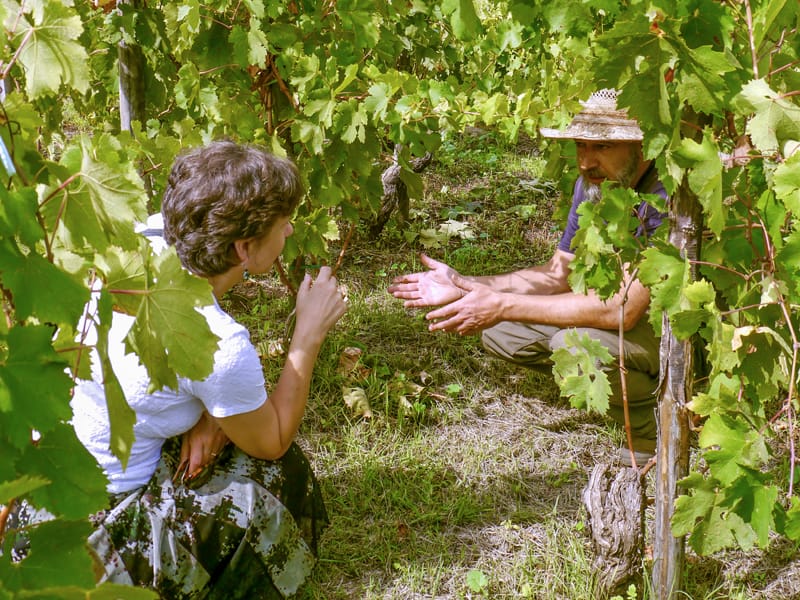
20 Wineries in Sicily Worth Visiting
There are many who have played an important role in bringing the island’s winemaking to its revered point today. Among them is enologist Salvo Foti, a consultant to a large number of wineries, who has brought a solid philosophy to the art of winemaking.

Families like Franchetti and de Grazia have brought techniques and innovation to Etna from the North. Relative newcomers like Cornelissen came from Belgium and explored the natural wine-making phenomenon on Etna.
The new generation, like siblings Loredana and Eugenio Vivera, (Vivera Wines), friends Nicola Adamo & Guido Grillo (Elios Wines) and offspring, like the daughters of the important Occhipinti and Alliata families, Ariana and Claudia, have brought new ideas and perspectives.
All of them injected thought, heart and passion into this renaissance on Sicilian soil and all of it translates to arguably one of the most exciting markets for lovers of wine, travel and consumers.
Below is a list of 20 wineries in Sicily from the provinces around the island. Winery visits are all enjoyable because each place shares its own story and wine philosophy. This list offers a variety of perspectives, but there are so many more. Leave 2 hours for a tour, tasting and some food. Appointments are necessary.
If you would like to know more about grapes in Sicily, see The Grapes of Sicily.
–Karen La Rosa
Province of Catania (Eastern Sicily)
Barone di Villagrande

25 Via del Bosco
Milo (CT – Mount Etna)
+39 338 9146668
http://www.villagrande.it
Here is one of the best places to see a vineyard terrace system. This is one of the oldest of the historic wineries. Visits go into the cellar but not the vineyards. A tasting lunch is a good idea.
Benanti

Contrada Monte Serra
Via Giuseppe Garibaldi 361
Viagrande (CT – Mount Etna)
+39 095 789 09 28
www.benanti.it
This historic and important family winery in Sicily is run by the twin sons today. The family still has influence in Sicily’s wine world. The tasting room reflects this history and although you will be taken into the vineyards, you won’t see the winemaking operations. The historic palmento (millstone) is preserved for viewing. The wines are easily obtainable in the USA.
Frank Cornellissen

Via Canonico Zumbo, 1 (frazione Passopisciaro)
Castiglione (CT – Mount Etna)
+39 349 8146187
https://www.frankcornelissen.it
This Belgian came to Etna with an idea to make wines with no intervention, to let the wines speak for themselves from this fertile soil. He was one of the first to work this way and his wines are now respected worldwide. The wines are easily obtainable in the USA.
Gambino

Contrada Petto Dragone
Linguaglossa (CT – Mount Etna)
+39 348 8220130
https://www.vinigambino.it
This family creates a great experience for visitors in the vineyard and the beautiful large tasting room. They make a variety of wines giving you a chance to taste several different labels. Wines can be ordered online. The wines are easily obtainable in the USA.
I Custodi
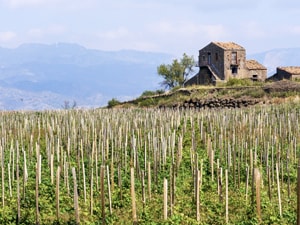
Contrada Moganazzi
Castiglione di Sicilia (CT – Mount Etna)
+39 393 1898430
https://www.icustodi.it
I Custodi is a young winery in Sicily, the owners of whom teamed up with legendary Etna winemaker Salvo Foti. They have a tasting program to help you learn about their philosophy that respects the land, traditions and people with modern attitudes that let the grapes shine. Beautiful views.
Tenuta delle Terre Nere

Contrada Calderara
Randazzo (CT – Mount Etna)
+39 095 924002
www.tenutaterrenere.com
I was always impressed with their early sustainability efforts. They were almost completely solar 12 years ago, before many others. Their wines are easily obtainable in the USA
Terra Costantino

Via Garibaldi 417
Viagrande (CT – Mount Etna)
+39 347 6081521
http://www.terracostantino.it
The story of old meets new is very evident at this Sicilian winery.
The winemakers have a passion that puts a high value on organic and some bio-dynamic principles.
It all comes together when you taste their wines and view the smoking volcano in the distance.
Vivera

SP 59/IV Contrada Martinella
Linguaglossa (CT – Mount Etna)
+39 320 5697010
https://www.vivera.it
This Sicilian winery with a view is run by a sister and brother, incorporating their family and their land. Their ideas are based on organic care of the lands and tuned into the ideas of happy workplace, happy workers, happy wine. Vivera also makes olive oil from their lands to the south and west.
Province of Siracusa (Eastern Sicily)
Cantina Marilina
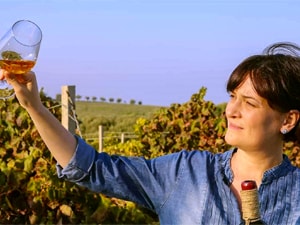
C.da San Lorenzo – Baracchino
Noto (SR)
+39 348 7589765
https://www.cantinamarilina.com
You’ll find Cantina Marilina in southeastern, not far from Noto and the sea.
Marilina, the daughter, runs this winery. Mamma Lina cooks.
It’s an organic winery, where you can taste a wonderful late-harvest Nero d’Avola.
The vineyards are in front. The focus here is on the wine tasting and food.
Zisola

Contrada Zisola
Noto (SR)
+39 0931839288
https://www.mazzei.it/it/Tenute/Zisola/La-tenuta/
This Sicilian winery, a branch of the Mazzei family, offers tastings of their wines and olive oils in the courtyard of the historic baglio. It is just outside of Noto and near the sea. Traditional wines of the area.
Province of Ragusa (Southeastern Sicily)
Riofavara

C.da Favara
Ispica (RG)
+39 0932 705130
http://www.riofavara.it
You can spend time here tasting not only the various still Sicilian wines, but their sparkling wine, as well. Here you can taste wine made with the historic Moscato di Noto.
Valle dell’Acate

Contrada Bidini
Acate (RG)
+39 339 4063138
https://www.valledellacate.com
At Valle dell’Acate there is a refined tasting room and tasting with a chef to pair foods with your wine choice.
Run by a woman, she is the 6th generation making wine here.
Frappato and the DOCG Cerusuolo di Vittoria wines are among the wines they are known for.
Gulfi

C’da Patria
Sp 7-8 Chiarmonte Gulfi (RG)
+39 0932 921654
https://www.gulfi.it
North of Chiarmonte Gulfi, this winery consults with Salvo Foti from Etna. This Sicilian winery has 2 excellent restaurants and the focus is on tasting the wines. The cantina/cellar was built with great attention by its founder, a pharmacist. They have a few lovely rooms in the locanda / inn where you can stay. The wines are easily obtainable in the USA.
Province of Caltanissetta (South Central Sicily)

Feudi del Pisciotto
Contrada del Pisciotto
Niscemi (CL)
+39 335 6873938
https://www.feudidelpisciotto.it/en/
Here you can see what was once the largest palmento (millstone) in Sicily. The traditional winery makes wines typical of the area, in a rural setting, not far from the cork forest. It is a wine relais with lovely accommodations.
Province of Palermo (Northwestern Sicily)
Alessandro di Camporeale

Contrada Mandranova
Camporeale (PA)
+39 380 6839492
http://www.alessandrodicamporeale.it
Not too far from Palermo and Monreale, Alessandro di Camporeale is another family operation.
The Alcamo region is known for white wines mostly, but here they offer both red and white to taste along with either lunch or nibbles.
These Sicilian wines are easily obtainable in the USA.
Feudo Disisa

Contrada Disisa SP 30 km 6
Grisì, Monreale (PA)
+39 091 6127109
http://www.vinidisisa.it
Lovely place to visit and taste wines from the Monreale area near Palermo. Tasting in the historic living room and dining room makes you feel right at home.. Along with the wines from indigenous Sicilian grapes, international grapes like Chardonnay are grown as well. The family will also offer you their outstanding flavored olive oils to taste.
Tasca d’Almerita
Contrada Regaleali
Sclafani Bagni (PA)
+390921544011
https://www.tascadalmerita.it

Tasca d’Almerita is an old and important Sicilian winery recognized in Europe for their sustainability efforts.
They have other facilities around the island but the old baglio here is beautiful.
The tour focuses on the wine but you can see some of the vineyards and gardens that support the Anna Tasca Lanza cooking school at the bottom of the hill. This family is all about wine, food, history and preserving tradition. These Sicilian wines are easily obtainable in the USA.
Province of Trapani (Western Sicily)

Elios
Viale Europa 280/a
Alcamo (PA)
+39 333 4095994
https://www.eliosfood.it
Two young guys studied business abroad and felt the pull to return to Sicily. They are making Sicilian wines with little to no intervention and a hip twist. You can sit under the trees in this rustic place with tasting facilities coming soon. They also cultivate honey and make olive oil.
Marco de Bartoli
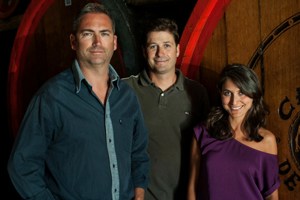
Contrada Fornara Samperi 292
Marsala
+39 0923 962093
https://www.marcodebartoli.com/en/
In the area of Marsala, you must learn about this historic wine and de Bartoli is the best place to do it. They produce other wines as well at a refined level. The tasting room is small but the tour through the barrel rooms and cave is historic and informative.
Province of Agrigento (South Central Sicily)
Cantine Barbera

C.da Torrenova S.P. 79
Menfi (AG)
+39 0925 570442
https://www.cantinebarbera.it/it/
Another Sicilian winery run by a woman with personality. Marilina is thoughtful and experimental. She recently made a wine without any electricity, because at one time it was done like that, so why not try? She produces several different labels and tries to capture the essence of her southwestern land by the sea in each bottle.
– Karen La Rosa is an Italian Wine Specialist, certified by the North American Sommelier Association, and the owner of La RosaWorks, a boutique tour company that arranges personalized itineraries and tours of Sicily for independent travelers.

This is a master article. It comes from such a deep knowledge, love and passion for Sicily that is priceless and infinite. Its value is forever. Thank you Karen.
Thank you so much, Giusi. I have thoroughly enjoyed visiting the people and the wineries. Every one of them is unique. Many years of tasting, learning, harvesting, studying and exploring has enriched me for sure. I love to share that knowledge and passion.
Always a pleasure to read your writings about Sicily. Your love of this special and spectacular place are apparent in every word. I always learn from you. Can’t wait to return to the homeland!
Thank you! Yes. We will return soon!
Beautiful article from a person that loves and deeply knows Sicily.
Thank you, Lori. The time I’ve spent exploring and the people I’ve met, some of whom I now consider family, have made the journey very rich indeed. There is so much to share.
great article Karen, another chapter closer to that book…. 🙂
Thank you very much, Alexandra! Maybe…. who knows? I can’t think of a better time than now to devote to writing! 🙂
Wonderful article, Karen! From our last trip, I fell in love with Grillo and Nero D’Avola. Can’t wait until we can travel again and return to Sicily!
Thank you, Roger. I’m sure you two are missing your annual jaunts. Sicily awaits! These are two excellent ‘memories’ to have. Fortunately we (in NYC) are able to purchase these wines more and more easily these days. You are right near Best Bottles and they can order a case of anything you want for you, which is also a good resource. Just ask. Stay well!
A superb article, Karen. So thorough and detailed, so evocative and so enticing. Many thanks.
Thank you, Helen. So glad you enjoyed it. All of my tours include opportunities to taste a variety of Sicily’s wine offerings at lunches or dinners and often at the wineries themselves as you well know. Including this aspect compliments everything else you see and do in Sicily in big, small, and delicious ways. I know you agree!
Sending my best across the pond!
Interesting and fun article. We have visited a few of these wineries with your help and it was delightful to see them here. We are eager to return to Sicily to learn and experience more.
Yes, Bev, you did. And there are so many more I could have mentioned. I’ve personally been to more than 60 – and I still have a list :-)! Like people, they are all different. When we can return, I would be happy to point you to places you didn’t visit last time. Hope all is well!
Salve, Karen,
Your article whetted my appetite not only for Sicilian wines but for the island’s spectacular landscapes, delicious food, and charming people. I loved the photos–including the one of you petting the baby goats–and (as a lit professor and wine-lover) the delightful quote from Horace. Let’s hope, pray it won’t be too long before we can visit Sicily and join you on that wonderful tour, which was sadly aborted by COVID-19. Stay well!
Hi Ellen, I know you would have loved your trip and you will, when you eventually go… I can get you to goats, too! I know I’m a little biased** and I have tasted a lot of Italian wine, but I really feel that Sicilian wines transport me to the island. Try it and see if it works for you. Thank you for reading. Sending all my best! Salute! **a little, LOL.
Thanks, Karen, for this extensive, fascinating and illuminating article. Your ability to portray the sights, scents and flavors of Sicilian wines is a gift.
Memories of our days in Catania are before me; your planning, attention to detail, creativity and enthusiasm make a joyful package. Ah, the wines! The landscapes, the food, the people!
Bravo e un milione di grazie.
Mi ricordo bene quel tempo sulle colline di Aci Castello e in giro. Thank you for reading, Paula! It is difficult to put Sicily into words. There are adjectives and descriptors galore, but as you know, being there is the only way to feel the magic of that place. Salute!!
Nice article! My next trip to Sicily was to be centered around the wineries of Etna. Maybe next year..
Thank you. Let’s hope, Kathryn, that we both can be over there soon. Etna is an amazing pace to be for wine. Personally, I can’t get enough. Salute!